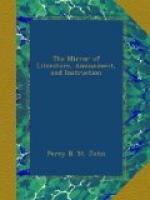Title: The Mirror of Literature, Amusement, and Instruction, Volume 12, No. 329, Saturday, August 30, 1828
Author: Various
Release Date: February 29, 2004 [EBook #11370]
Language: English
Character set encoding: Us-ASCII
*** Start of this project gutenberg EBOOK mirror of literature, no. 329 ***
Produced by Jonathan Ingram, Allen Siddle and the
Online Distributed
Proofreading Team.
THE MIRROR OF LITERATURE, AMUSEMENT, AND INSTRUCTION.
No. 329.] Saturday, August 30, 1828. [Price 2d.
NEW CHURCH, BUILDING AT STAINES.
[Illustration: New church, building at Staines.]
Who has journeyed on the Exeter road without noticing the town of Staines, with its host of antiquarian associations—as the Stana (Saxon) or London Stone,[1] its ancient bridge, for the repair of which three oaks out of Windsor Forest were granted by the crown in the year 1262, besides pontage or temporary tolls previous to the year 1600.—Dr. Stukeley’s conjectures respecting the Via Trinobantica passing here—and the old parish church, the situation of which appeared to denote the site of the more ancient town of Staines. It is here too, that the tourist begins to imagine himself in rure, after he has been whirled through the brick and mortar avenues of Kensington, and Hammersmith, and the unsightly lane-street of Brentford,[2] with all its cockney reminiscences of equestrianism and election squabbles; Hounslow and its by-gone days of highway notoriety and powder-mill and posting celebrity, and Bedfont, with its yew trees tortured into peacock shapes, and the date 1704. Then, who does not recollect and venerate the convivial celebrity of this route, its luxurious inns, and their “thrones of human felicity;” along which Quin, Dr. Johnson or Shenstone could scarcely have accomplished a stage a day!
In our days, hundreds of London tourists breakfast at the Bush, although, after sixteen miles’ ride, their appetites do not require this stimulant any more than do the glories of the Bush cellars after dinner.
But we must pass on to the church. The old building was in the Gothic or pointed style, with lancet windows, &c., but much disfigured by churchwardens’ repairs, although the great Inigo Jones is said to have built its square, brick tower. At length, a considerable portion of this ancient structure fell in one Sunday morning, during the service, but, as the newspapers say, “fortunately no lives were lost.” The inhabitants then resolved to rebuild nearly the whole, and the design of Mr. J.B.




